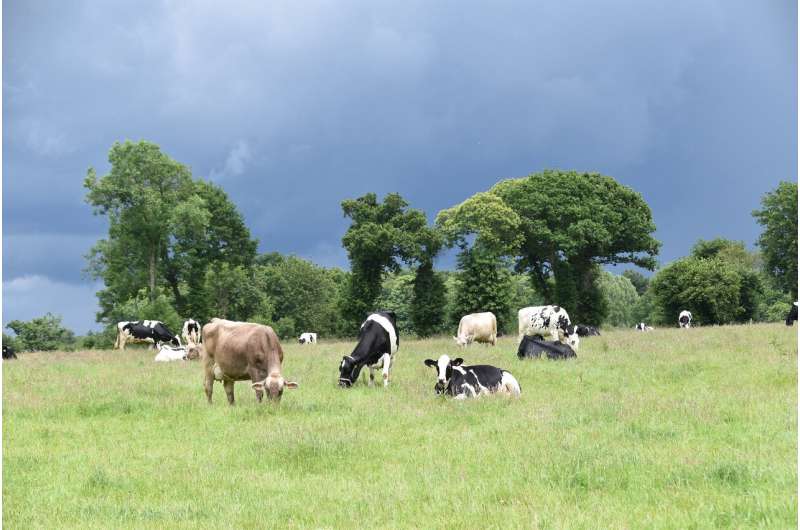Study outlines new blueprint to help tackle the biodiversity impacts of farming

Sadie Harley
scientific editor

Robert Egan
associate editor

A study led by researchers at the University of Oxford, working closely with colleagues from Duurzame Zuivelketen (DZK), among others, has developed a framework to help agricultural sectors better contribute to global biodiversity targets without causing unintended harms.
Published in , the study is based upon data from the Dutch dairy sector in 2020, covering nearly 8,950 farms (approximately 1.6 million cows).
They first established a single combined score to track biodiversity impacts against possible sectoral targets, but found that while using such a score can be helpful to track overall progress, such methods can mask important local impacts (such as nutrient pollution or habitat loss) that are currently poorly captured with existing biodiversity impact indicators.
To address this, the team developed a set of safeguards—clear, quantitative thresholds for major environmental pressures—to ensure progress in one environmental impact type does not come at the expense of other types elsewhere. If each of these safeguards were fully implemented, the researchers estimated this could take the sector most of the way towards biodiversity targets such as those outlined in the Global Biodiversity Framework.
Lead author, Associate Professor Joseph Bull, from the University of Oxford's Department of Biology, said, "Our study shows that—though they are extremely useful—relying on simplified, combined indicators to track agricultural impacts on biodiversity can mislead if used alone. By introducing scientifically grounded safeguards, we can ensure that improvements in one area don't cause damage somewhere else."
Measuring the biodiversity footprint of dairy farming
To understand where biodiversity losses were occurring, the team worked with a single composite index that translated environmental pressures—such as greenhouse gas emissions, land use change and ammonia emissions—into a common unit. This value reflects the proportion of species at risk of disappearing from a particular area.
The analysis revealed that, for some measures, the majority of biodiversity harm was not happening on Dutch farms directly, but overseas, particularly where land is cleared to grow livestock feed ingredients. These imported feeds were responsible for the largest share of land transformation impacts, and consequently biodiversity loss.
By contrast, nutrient pollution, while a major political and environmental issue within the Netherlands, had a relatively modest effect on global biodiversity loss. This shows the value of using multiple criteria to target the most effective interventions on biodiversity.
Developing and applying safeguards
To avoid unintended outcomes when using single metrics to track biodiversity progress, the researchers proposed a set of practical safeguards. These act as checks and balances, ensuring that improvements in one area do not mask problems in another.
The safeguards fall into two main categories:
- Impact prevention: These include thresholds for the use of imported animal feed, limits on nitrogen and ammonia emissions, and targets for maintaining permanent grassland and biodiversity-rich habitats. Together, these measures aim to reduce environmental pressures before damage occurs.
- Impact compensation: For biodiversity losses that cannot be avoided, the study outlines to what extent the sector could offset impacts by restoring similar habitats in the same regions where damage has occurred. Safeguards here include ensuring compensation happens promptly and is maintained long term.
The approach was developed in collaboration with Dutch dairy stakeholders, including industry bodies and conservation organizations, and is tailored to align with national policies and international biodiversity goals.
Pathways to nature-positive outcomes
The study outlines three feasible transition pathways for the dairy sector, from offset-heavy "adaptive compensation" to a "deep net positive" approach driven primarily by prevention. Each pathway presents trade-offs, particularly between production levels, land use, and restoration potential.
Co-author Dr. Joseph Poore (Department of Biology, University of Oxford) added, "This study was an interesting test of whether single biodiversity impact scores, that capture many pathways causing biodiversity loss, are practical to implement and reliable. Our results generally found that these indicators serve a very useful role and the science is advancing fast.
"Soon we will probably know the biodiversity impacts of every product we buy in the shops and the biodiversity impacts of businesses and their choices. While not the solution to these problems in itself, this is certainly a step towards solving them."
More information: Towards positive net outcomes for biodiversity, and developing safeguards to accompany headline biodiversity indicators, npj Biodiversity (2025).
Provided by University of Oxford



















